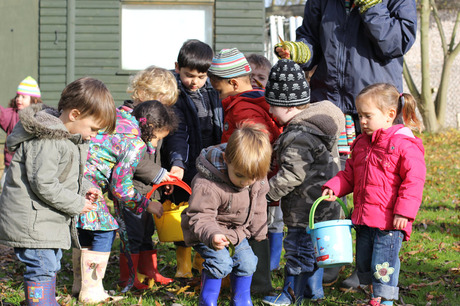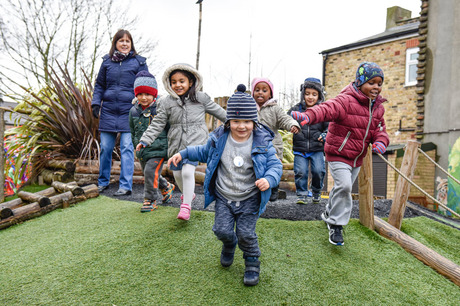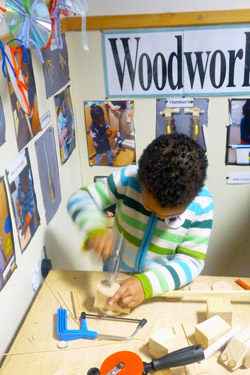
Terms such as ‘the more able’, ‘high ability’ or ‘gifted and talented’ are often received with scepticism or alarm bells in early years settings. To label and categorise a child so young just doesn’t seem right. Furthermore, the implication of this sort of labelling is that the others are deemed to be not these things: the non-high ability, the not more able and the non-gifted and talented children.
However, that said, who wants to be responsible for overlooking a child’s aptitudes and talents? Not all children will have the good fortunes of Paul McCartney and George Harrison, who were told at school that they showed no musical talent. So, how do we set about approaching this issue in the early years?
The Gifted and Talented programme has been the response to this question in many schools. Though there is not a nationally accepted definition or working model of ‘gifted and talented’ as such, it generally means that certain children are recognised as excelling in one of more areas of the curriculum and need specific provision for this. It is, basically, approached as a special or an additional need in terms of there being a number of children that are identified on the grounds of their learning ability and provided for.
CASE STUDY: WITHOUT LIMITS AND CEILINGS

The Wroxham School, headed by Dame Alison Peacock, has become well-known for doing something quite unusual. Informed by the work of Carol Dweck on ‘mindset’, Ms Peacock and her team have decided against using any sort of labelling or ability-focused language throughout the school. Terms such as bright, gifted, SEN, average, the top set and the bottom set are all considered pejorative in that they are statements about the child’s level, not their learning or expertise. Consequently, such language is not used when teachers speak to one another about the children or when they speak with parents.
Perhaps more importantly, the pupils at the Wroxham school do not categorise or position each other in terms of their labels and levels, whatever they might be. A label, for Ms Peacock and her staff, is always seen as one of the ways in which we comment on a child’s innate ability or mindset. The inherent problem with this is that it has a ceiling. ‘If you’re told you’re gifted, the problem is you’ve got an awful lot to lose. The evidence is that children stop trying, refuse to move out of their comfort zone, they don’t want to fail,’ says Ms Peacock. Dweck’s research couldn’t be more clear: children who are told they are clever, talented and so on are shown to give up. The threat of failure following success is rarely a lure.
Similarly, the word ‘potential’ is not part of the vocabulary at Wroxham. Harmless and open-ended though it may first appear, it is yet another way of saying that there is a fixed capacity or level to be reached: another ceiling or limit to learning. Peacock thus considers ‘gifted and talented’ to be at best unhelpful and at worst limiting to the child’s further development.
So, what do they do instead of this at Wroxham? Central to their teaching are learning processes and the development of these. Focusing on the skills that a child uses and the approaches they take during an activity says something to them about what they are doing and the processes they are involved in. Dweck’s research suggests that this sort of feedback focused on the learning process allows the child to get an idea of the skills they have, those they need to consolidate and those they need to develop further. They are not faced with an inhibiting limit but engaged in an active learning process that is to be ongoing, to be continued. What is significant here is that it is particular to each and every child and that no child is excluded – challenging and extending a child’s aptitude is not for a select number of children, but for all of them.
Ms Peacock, steadfastly committed to giving all children a fair and equal chance, does not shy away from children who might excel or who manifest a particular passion over and above the more usual. ‘We do, however, recognise that some children are particularly excited to learn about different areas of the curriculum and already have a great deal of knowledge or expertise to share,’ she says. ‘Excellent teaching requires building on each child’s learning and allowing for flexibility, without fear of moving into territory that has not been planned.’
Noticing, pursuing and developing each child’s personal captivations and proficiencies is, for Wroxham School, an obligation of good practice and the right of each child.
GUIDANCE: EXPLORING FASCINATIONS
It seems to follow in a similar vein that the National Strategy for Gifted and Talented provision in the Early Years is entitled Finding and exploring young children’s fascinations (first published by the then Department for Children, Schools and Families (DCSF) in 2010). This title immediately makes it clear that the guidance is for all children – not only a select few children have fascinations. The word ‘finding’ is apposite: children arrive in the early years with a huge variation in life experiences – some might have what is often referred to as a rich home life, while others have not benefited in the same way. Some children, then, will have an idea about their fascinations while others may need to begin the process of finding them.
The document goes on, ‘This guidance draws on current research evidence and practitioner case studies to explore how each child’s unique strengths, interests, aptitudes and passions can be recognised, celebrated and nurtured in the Early Years Foundation Stage (EYFS)’. Throughout this report there is a fundamental message about approaching ‘gifted and talented’ in the early years – the individual child and the learning environment are inseparable. The report states, ‘The earliest years are a critically important time and practitioners have responsibility to create environments in which learning and development can flourish and their gifts and talents can be recognised, nurtured and extended.’
Young children, then, must be offered learning environments in which they can begin to find and pursue their fascinations. In early years settings, the need to think about the nature of such provision and how it might be achieved is imperative.
KEY CONSIDERATION: CRITICAL THINKING
Sir Ken Robinson, former professor of arts education at Warwick University, is well-known for the uncompromising emphasis he puts on the need for creativity in education. Creativity, for Mr Robinson, is the consideration when it comes to the curriculum and learning environment. Here he is using creativity in its broadest sense – he is not referring to creative tasks and activities as such but creativity that is connected with critical thinking. This is about the way we use our imagination and thinking skills to make new connections and find inventive solutions – a creative way of thinking.
Mr Robinson is critical of many approaches to education which he considers to be ‘stifling some of the important capacities that young people now need to make their way in the increasingly demanding world of the 21st century – the powers of creative thinking’. His approach underpins the requirement in the EYFS for practitioners to foster children’s creative and critical thinking, one of the strands in the Characteristics of Effective Learning (see The Element: How Finding Your Passion Changes Everything by Ken Robinson and Lou Aronica, 2009).
CASE STUDY: THE PROCESS OF LEARNING

Sheringham Nursery School and Children’s Centre in Newham works in a way that reflects both Ms Dweck’s work on the importance of the process of learning, rather than products or outcomes, and Mr Robinson’s emphasis on the need for creative opportunities in education. Lesley Webb, the deputy head teacher, considers interactions between children and adults to be critical and at the heart of practice that addresses a range of abilities. ‘Staff training on sustained shared thinking and having proper conversations that encourage the children to think is central to what we’re doing here at Sheringham. Comments such as, “That’s very good – well done”, or closed questions like, “What is that you’ve drawn?”, are to be avoided – they don’t do anything to engage with what the child is doing or move them on in their learning.’ This reflects Ms Dweck’s emphasis on adults providing feedback on the learning process, and not on the final product, in order to foster children’s creativity.
Staff at Sheringham value the time spent listening to and talking with children, and try to avoid taking short-cuts. ‘If children are given answers and solutions to problems or told and directed too much, they lose the opportunity of really thinking – it short-circuits their learning processes and further development,’ Ms Webb comments. ‘Having said that, of course, it is important to be able to give them enough taught input to be able to move on and further what they are doing – it is often a fine line.’
 Sheringham aims to offer all children scope to develop their creative and critical thinking through the provision of an environment rich in opportunities for investigation. It is through engagement in open-ended activities that each child, supported by an adult, can get absorbed in talking about and questioning what they are doing. The use of photographs in children’s Learning Stories and Special Books enables the children to look back on their learning, both in the nursery and at home with parents. Ms Webb explains that ‘this enables them to start to reflect on their learning and then take it further’.
Sheringham aims to offer all children scope to develop their creative and critical thinking through the provision of an environment rich in opportunities for investigation. It is through engagement in open-ended activities that each child, supported by an adult, can get absorbed in talking about and questioning what they are doing. The use of photographs in children’s Learning Stories and Special Books enables the children to look back on their learning, both in the nursery and at home with parents. Ms Webb explains that ‘this enables them to start to reflect on their learning and then take it further’.
The Bow Arts Trust
Sheringham also aims to provide a diverse and exciting curriculum with as many openings as possible for children. Finding and exploring children’s fascinations argues that ‘all children are entitled to provision that reflects their unique characteristics, fascinations and enthusiasms. It is important to identify all children’s strengths and interests at every stage in their development to ensure that this entitlement is met’.
The Bow Arts Trust, an educational charity based in East London, contributes extensively to this provision. For example, its artists recently worked on a large-scale project in the Sheringham garden which started with wooden posts and ‘found’ materials. The children were invited to add whatever they liked to the wooden posts. One child brought along a picture that she wanted to stick on – she did so. At this point an adult got engaged in talking with the little girl about her idea and contribution. As the conversation went on, she came to realise the potential problem of paper and the outdoors. This led to her coming up with the idea of making a wooden door or shutter that would act as a cover and protection for her picture.
The amount of step-by-step thinking that evolved from this simple activity is self-evident. For Ms Webb, this is a fine example of a child developing their critical and creative thinking through the timely coming together of a rich physical environment and telling interactions with an adult. ‘This is exactly what we’re aiming to do – such moments must be made the most of.’
Forest School
The Forest School at Sheringham is another project that provides a wealth of creative opportunities with a focus on processes. Ms Webb finds every visit fascinating because of the way that being in the Forest School prompts children’s critical and creative thinking and enquiry: ‘Is it best to lift a log or use a pulley system? If you climb to the top of a tree how are you going to get back down? Why does everything smell different after rain? These are the sorts of questions that naturally arise.’ One of the children, who is on the autism spectrum and currently non-verbal, had benefited particularly from his time spent in the Forest School. ‘Every time we go he revisits the things he remembers from the previous time and points them out to me,’ says Ms Webb.
In Forest School, there is time and space for those all-important spontaneous curiosities and interests that come from the children – which can happen at any moment. Ms Webb comments, ‘Children can suddenly become interested or provoked and be ready to take off – we have to be ready for this.’
In the moment
Anni McTavish, the early years and creative arts consultant who spent a year working on a project with Sheringham, stresses the importance of being able to be in the moment with a child – to allow that something to happen that was not planned for. ‘It can be a risky business, but necessary if we are to enable the development of children’s play,’ she says.
During her recent work with Sheringham, Ms McTavish noticed two children who wanted to build a high wall – it was incidental and happened as other outdoor work was going on. She explains, ‘They had such energy and enthusiasm about it – it was my role to join them in their curiosity and excitement and enable them to follow their ideas as much as possible.’ The leader of the two children was excited that the wall should be very high – he was very confident and seemed to have a lot of knowledge and experience of building with blocks. The children went ahead and used the blocks to build a wall that ended up being five feet tall and similar in length, with Ms McTavish showing a keen interest in their thoughts: ‘They seemed to need a bit of reassurance and a sort of permission to carry through their ideas.’
Through conversation with Ms McTavish, they came to recognise the importance of putting a sign up to prevent others riding or running into it. ‘It was a risky piece of play in the sense that there were lots of unknowns about it for me. Was it safe for them to build a high wall? Would it be sensible to encourage it? Was it okay to go off plan and let this happen? Being able to be in the moment with the children, we explored the questions together and I tried to support them in coming up with safe solutions, which they did.’
This work reflects Chris Pascal’s thinking about ‘gifted and talented’ in the EYFS: ‘The setting up of enriched environments is critical, though it is all too easy to make an environment over-stimulating. Most gifted and talented children prefer to investigate in depth rather than flit from one superficial task to another. The level of openness in the resource and environment should be such that the child is able to explore boundaries, allowing uniqueness to emerge. It is in this zone that many gifts and talents emerge’ (DCSF, 2006).
Practitioners may find labels such as ‘gifted and talented’ useful – or they may prefer the approach advocated by Ms Peacock and others which cautions against labelling children like that. In either case, it is surely the responsibility of early years practitioners to provide opportunities for children to have, as it says so beautifully in Billy Elliot, ‘those moments of profundity and creativity’, whatever their circumstances. ‘But more than that, we have a duty to ourselves and each other to create a society where this possibility in all of us is nurtured and can flourish’ (Billy Elliot the Musical).
MORE INFORMATION
Finding and exploring young children’s fascinations: Strengthening the quality of gifted and talented provisionin the early years, www.foundationyears.org.uk/wp-content/uploads/2011/10/Finding_Exploring.pdf
The Bow Arts Trust, http://bowarts.org
Carol Dweck (2012)Mindset: How You Can Fulfil Your Potential.Robinson
Anni McTavish (2013)Playing and Exploring (Learning and Teaching in the Early Years).Practical Pre-School Books
[asset_library_tag 1113,Download the PDF]









